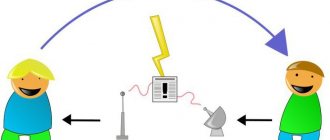Types of communication
Depending on how communication occurs, on the specifics of people’s behavior, the following types :
- Primitive . Its peculiarity is indifference to the interlocutor, reluctance to understand him, as a rule, accompanied by fast, dismissive speech.
- Formal - or the level of masks. It is also characterized by a lack of interest in the interlocutor. Well-worn phrases, ostentatious politeness, false sympathy - this is a set of cliches under which it is easy to hide the true attitude towards another.
- Secular - empty, meaningless, ritual behavior. Filled with dialogues accepted in appropriate situations, when their content is of no interest to either side.
- Role-based - the basis of the attitude towards the interlocutor is not personal interest, but his social role.
- Business communication already presupposes closer relationships. Focus on results forces you to take into account the character traits, even the mood of your interlocutor. At this level, it is necessary to maintain distance, and the businesslike style characterizes the seriousness of the relationship.
- Interpersonal is close contact with the interlocutor, genuine interest in him.
- Manipulative level of communication - aims to achieve personal gain. The interlocutor is seen as a means, a living instrument on the path to personal interest. The “diplomatic” style is often used to resolve everyday issues.
- Playful or informal communication style . Friendly, light with a humorous twist, communication or flirting, a game devoid of obligations.
- Spiritual level . The highest degree of frankness in a relationship, when a person fully opens up in communication.
The psychology of professional communication can be placed in a separate category. Communication of this kind can be very different depending on its objects.
How to communicate with impossible people
Difficult people require a special approach during conversation. If you need to contact an unpleasant person, you can minimize the receipt of negative emotions using 5 basic rules:
- You should not take your opponent’s criticism or advice that you haven’t asked for personally.
- If your interlocutor likes to interrupt, you should not allow him to do so. This requires politely explaining to the person that his arguments will not be heard until the speech is finished.
- If the interlocutor does not want to talk, but you need to get an answer from him, in this case the best communication is to briefly state the essence of the question.
- We should not forget about the ability to listen to your opponent. Thanks to an attentive attitude towards the interlocutor, respect for his words and thoughts will be visible.
- There is no need to teach a person to communicate if he does it somehow wrong. Each individual has his own way of speaking. Therefore, an evaluative conversation will only irritate.
Communication is the key to the whole world. Careful study of the operating instructions and proper use will make it easier to achieve your goals.
Communication functions
- The pragmatic function of communication (or communicative) is the interaction of people at the level of interpersonal or intragroup communication. Communication is an important need for humans.
- The function of formation and development is that communication has a certain impact on the participants in communication, contributes to their development and improvement in all respects. Through communication with other people, a person learns social norms and values that have developed in society, gains knowledge and develops as a person.
- The confirmation function allows communication participants to recognize and confirm themselves.
- The function of uniting and separating people. Communication, on the one hand, facilitates the establishment of contacts between participants in communication, through which the necessary information is transferred. In addition, communication sets up communication participants to achieve common goals and objectives and thereby connects them into a single whole. On the other hand, communication can contribute to the isolation of the individual, as well as differentiation in the communication process.
- The function of organizing and maintaining interpersonal relationships. Communication helps to establish and maintain contacts and relationships between participants in communication, facilitating their joint activities.
- The intrapersonal function of communication is the communication of a person with himself. This can occur in the form of internal or external speech, which is completed as a dialogue. Such communication can be regarded as a universal way of thinking.
In accordance with the functions performed, three sides of communication :
- communicative , which consists in the exchange of information between participants in communication;
- the interactive side of communication lies in the interaction of people in the communication process;
- the perceptual side of communication, which lies in the fact that in the process of communication people perceive each other in a certain way.
Communication and its functions
Levels of communication: ritual or social-role; businesslike or manipulative; intimate and personal.
1. Ritual, or social-role level. The purpose of communication at this level is to fulfill the role expected of a person and demonstrate knowledge of the norms of the social environment. Communication in this case is, as a rule, impersonal in nature (in meaning), regardless of whether it occurs between strangers, acquaintances or close people.
2. Business, or manipulative, level. The purpose of such communication is to organize joint activities and search for means to increase the effectiveness of cooperation. In this case, partners are assessed not as unique, inimitable individuals, but from the point of view of how well they can complete the tasks assigned to them, that is, their functional qualities are assessed. Accordingly, communication is psychologically detached - the so-called dominates. “I–You” contact.
3. Intimate and personal level. The purpose of communication is to satisfy the needs for understanding, sympathy, empathy, and acceptance. Communication at this level is characterized by psychological closeness, empathy, trust - the so-called dominates. “I–You” contact.
The functions of communication are considered from the socio-psychological perspective of the three aspects of communication and interaction between people analyzed above: communicative, interactive and perceptual. The following communication functions are distinguished: contact; informational; motivating; coordination; understanding; emotive; relationships; influence.
1. Contact function is the establishment of contact as a state of mutual readiness to receive and transmit information messages and maintain relationships in the form of constant mutual orientation.
2. Information function is an informative exchange of messages, opinions, plans, decisions.
3. The incentive function is a certain socio-psychological stimulation and/or interpersonal motivation for the activity of a communication partner, in order for him to perform certain actions and make certain decisions.
4. The coordination function is mutual meaningful orientation, which has activity significance for communication partners, and semantic coordination of actions when organizing joint activities.
5. The function of understanding is, ideally, adequate perception and understanding of the meaning of information messages, and mutual understanding of intentions, attitudes, experiences, states of each other by communication and interaction partners.
6. Emotive function – creating in a communicative partner the emotional experiences necessary for a given particular subject of communication, as well as changing his experiences and states with his help.
7. The function of establishing relationships is the awareness of the subject of interaction and the fixation by him, from the perspective of interaction with various subjects of communication, of his socio-professional place in the system of role, status, business, interpersonal and other relationships of the society (community) in which communication takes place.
8. The function of exerting influence is a change in the state, behavior, personal and semantic formations of a communication partner, carried out through the use of various psychosocial techniques of influencing him.
Communication styles
In communication psychology, there are several styles:
- Ritual communication is communication in which the main task is to maintain relationships with other people. In real communication, there are many so-called “rituals” - situations when a person behaves in a strictly defined way. All that is required from him is knowledge of how to behave in each specific case. For example, greeting acquaintances or strangers, talking about the weather and everyday problems - all these are elements of ritual communication.
- Manipulative communication is communication that comes down to the fact that one of the participants in the communication manipulates the other, i.e. One of the participants is a means to achieve a certain goal. But you should not assume that such communication is only negative. Professional communication and communication for the purpose of learning are manipulative in nature. In order to successfully cope with this type of communication, it is necessary to know the goals of the interlocutor, as well as the laws and techniques of manipulative communication.
- Humanistic communication is more of a personal communication that involves understanding and empathy. It is impossible to determine any single goal of humanistic communication. An example of such communication is a conversation between a doctor and a patient, pedagogical communication, etc.
- Authoritarian communication implies authoritative communication by one of the participants in communication. He does not encourage the initiative of his interlocutors; he considers his point of view to be the only correct one.
- Democratic communication - this style is characterized by encouraging the initiative of participants in the conversation, paying attention to the interests and goals of all participants in communication.
- Liberal communication. People who adhere to this style of communication are rather uninitiative, “go with the flow”, and make concessions to other participants in communication.
You need to especially carefully select your communication style when working on the psychology of communication with a client - this can be done in our online courses.
Share this article:
I liked the article
Emotional communication
Human activity is impossible without communication; Throughout our lives we exchange information with our own kind. There are different types and forms of communication. emotional communication is .
Some associate communication exclusively with speech, but this is the wrong approach: a person begins to communicate long before he masters coherent speech
. Therefore, we can conditionally distinguish two types of communication: verbal and emotional communication.
A child’s need for communication appears at the age of approximately one to two months, long before he begins to master speech. Already from the first months of life, the child begins to use emotional communication
, while he begins to master verbal communication at the age of about a year.
Emotional communication is communication through facial expressions, gestures, postures, intonations
. In infancy, direct emotional communication between mother and child (physical contact, voice intonation, smile addressed to the child, etc.) is very important, as it helps to establish a stronger connection between mother and baby.
The task of the mother (or another loved one who cares for the child) is to satisfy his need for emotional communication as fully as possible
. Direct emotional communication gives the child a joyful mood and increases his activity. In addition, emotional communication provides the basis for the development of the child's perception, thinking and speech.
Over time, the child masters speech, but this does not mean that the time has come to say goodbye to emotional communication forever. In the context of communication between adults, emotional communication often means a type of communication in which the exchange of emotional information is the leader in the communication process.
.
In principle, this does not contradict what was said above: in emotional exchange, it is nonverbal means of communication that play an important role
(facial expressions, gestures, postures, intonations).
Emotional communication in this case consists of three main components: cognitive, subjective and expressive.
. The cognitive aspect refers to the perception of feelings and emotions by communication partners. The subjective aspect is the experiences caused by interpersonal relationships. The expressive aspect is the expression of emotions towards a communication partner (both verbal and non-verbal).
Sometimes emotional communication is presented as a way of manipulating people. Some people actually use this type of communication to manipulate others. As we have already said, this type of communication is primarily used to exchange emotions, including through facial expressions and gestures. However, if you can express an emotion through a gesture or facial expression, the opposite is also possible: use a facial expression or gesture to make it seem like you are experiencing a certain emotion
. This is manipulation.
How to avoid falling for this hook during emotional communication? The so-called emotional intelligence is responsible for awareness and understanding of both other people’s and one’s own emotions. The higher the level of emotional intelligence of a person, the less likely he is to be fooled
during emotional communication.
To avoid becoming a victim of a manipulator, you need to pay more attention to the body language of your interlocutor. The fact is that a person is usually not able to suppress (at least instantly) or imitate some physiological reactions that accompany emotions. These include, for example, the reaction of the pupils, breathing and pulse rates, etc. Therefore, attention should be paid not only to gestures and facial expressions that a person can use consciously, but also to those signals that are practically beyond control
.
So, emotional communication is most important in infancy, but even after we master speech, it continues to play a significant role in our relationships
with the people around you.









